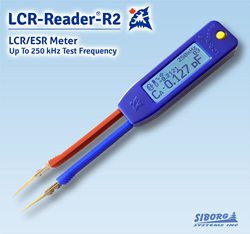
LCR-Reader-R2 LCR/ESR meter from Siborg Systems Inc.
LCR-Reader-R2, with 250 kHz test frequency, will be on sale this October from Siborg Systems Inc.
WATERLOO, ON (PRWEB)
August 23, 2021
Canadian Siborg Systems Inc. has finished the final touches on their newest model, the LCR-Reader-R2. The R2 is the latest model in the LCR-Reader line of tweezer-meters and boasts a 250 kHz test frequency for the first time amongst all tweezer-meters to-date. Siborg will be holding a sale on the LCR-Reader-R2 in October.
The LCR-Reader-R2, based on the LCR-Reader-MPA model, combines features from previous models and offers more stability while testing in-circuit measurements. The stability is due to the ability to switch test signal source resistance from 100 Ohms to 1.4 kOhms. The higher source resistance reduces noise when measuring small resistances.
The new device utilizes a different, more powerful MCU and therefore allows to process measurements at higher frequencies. It also allowed to implement an additional test feature, namely Analog Signature Analysis. This is a circuit board troubleshooting technique that uses an AC sine wave across two points of an electronic component or a circuit. The resulting waveform is displayed using current and voltage as x and y axis. This signature is compared to that of the known good circuit board or component allowing to determine the board or component health.
When initially announced, the R2 was supposed to offer a 300 kHz test frequency. After some preliminary testing, this value was found to be too high without sacrificing measurement accuracy. Instead, the R2 offers up to a 250 kHz test frequency still offering 0.1% basic accuracy. The 250 kHz test frequency, along with the change in source resistance, is very important while testing small capacitance and inductances, and also while testing in-circuit.
The LCR-Reader line of multimeters uses a set of tweezers as probes integrated with a high accuracy multimeter akin to Smart Tweezers LCR-meter. When the devices’ gold-plated tweezer tips grasp a component, it will automatically determine the type of component and best test parameters to use before measuring. All measurement values are instantly available on the display, including the test results (LCR and ESR values), test frequency used and component type. LCR-Readers are lightweight and compact making them useful for on-field work, and make short work of identifying unknown components.
Some major differences between the R2 and MPA models is the removal of AC/DC current measurements, AC/DC voltage measurements up to 15 V, Frequency meter, and Oscilloscope.
The LCR-Reader line of multimeters started in 2014 with the flagship LCR-Reader model as a budget alternative to Smart Tweezers LCR-meter. This model has a 0.5% basic accuracy and very limited testing capabilities. Users are only able to select the test mode (Auto, L, C, R and ESR) and the device determines which frequency is the best for the measurement (100 Hz, 1 kHz, or 10 kHz). Since the launch, Siborg has created the LCR-Reader Colibri, LCR-Reader-MP, LCR-Reader-MPA, Low Frequency MPA and MPA with Bluetooth.
Features on LCR-Reader-R2:
-
Automatic and manual LCR, ESR, LED/Diode measurements - 0.1% Basic accuracy
- Automatic test signal reduction to 0.1 V for in-circuit measurements
- Three test signal levels, 0.1, 0.5 and 1 Vrms
- Automatic and manual test frequency; including 100, 120 Hz, 1, 10, 20, 30, 40, 50, 60, 75, 100 and 250 kHz
- Parasitic offset removal using easy Short/Open Calibration
- Measures components to a 0201 size (0.3 mm)
- 1.5 oz. weight
- Backlit LCD
- Displays active and reactive impedance components
- Gold-plated test leads
- NIST traceable calibration certificate
Siborg will be offering a discounted price in October for LCR-Reader-R2 in their LCR-Reader Store, and on their Amazon sales channels in North America and Europe. Siborg also offers other test equipment and accessories, including Smart Tweezers, Kelvin Probe Connector kit, Offset Calibration board, spare probes and more.
Share article on social media or email:

